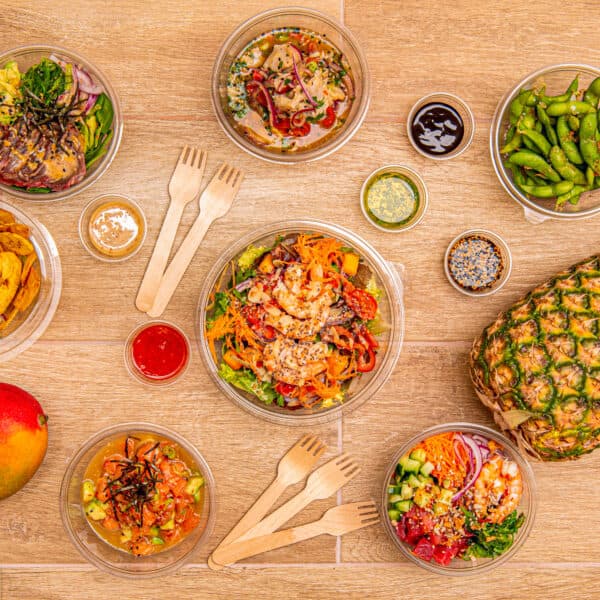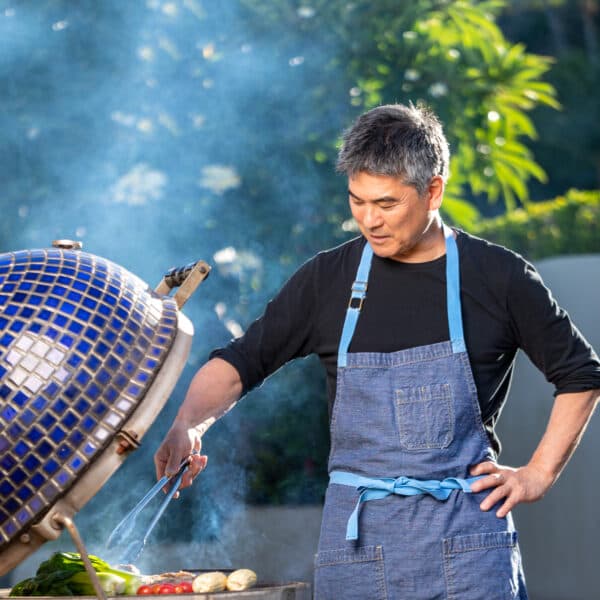Destination Hanapēpē
Once the bubbling epicenter of life on Kaua‘i, Hanapēpē town has reinvented itself time and time again proving to be “the town that refuses to die.
BY Krystal Kakimoto
Located in the southwestern part of the island, between Kōloa and Waimea, Kānaka Maoli (indigenous people of Hawai‘i) were drawn to the area of Hanapēpē Valley because of the lush, volcanic soil that supported their banana, sweet potato and taro crops. The area became known as Hanapēpē, alluding to the landslides that happened deep in the valley, and an established community blossomed here long before European explorers visited the islands.
The height of Hanapēpē’s glory fell between post-World War I and the 1950s as buildings were constructed through what is now known as, Historic Hanapēpē Town. GI soldiers stationed nearby flooded to Hanapēpē where they could visit the USO Club, play a game of pool, or catch a show at the Aloha Theatre. Locals knew if you needed to buy big-ticket items such as cars, appliances or jewelry, Hanapēpē would be the best place to go. They also headed to the area for nighttime entertainment as the tiny town that measured only one square mile was home to the island’s bowling alley, an arcade and two roller skating rinks!
Despite the bustle of Hanapēpē, the vibrancy dulled over the coming decades due to external forces. One reason was the realignment of Kaumuali‘i Highway which was moved to skirt the town. Another reason was a push to centralize shopping activities to the area of Līhu‘e, where the island’s main airport and biggest port were located. The final catastrophic blows were when Hurricanes Iwa and ‘Iniki blew through the island in 1982 and 1992. Parts of Hanapēpē town were flattened and many worried this quaint corner of the island would never rebound from the successive hits.
Rather than fade into the shadows, the inhabitants of Hanapēpē gathered for the town they loved, and the area underwent a cultural renaissance. The historic main street was rebuilt, and businesses began popping up. Kaua‘i’s “biggest little town” leaned into its charm and the community of artists who had migrated to the area helped make it become known as the art capital of Kaua‘i. As of 2020, only 2,678 people call Hanapēpē home but much more head to the area for either a fun day trip or for their beloved Art Nights held each Friday from 5 to 8 p.m.
As you drive along Highway 50, veer right at the “Welcome to Hanapēpē” sign which will take you to Hanapēpē Road leading directly to historic Hanapēpē town. Don’t drive too fast down this road or you may miss the legendary Taro Ko Factory. Once you’ve found the dilapidated green cottage along the left side of the road, pull into their tiny parking lot for a chance to taste some of the best taro and sweet potato chips in the state. This family-owned business was started by Shoichi Nagamine and his wife, Shizuko, in 1985 after the two retired as taro farmers. They fried some lehua kalo (Native taro used to make red poi) for friends without realizing people would want to buy their chips. Now decades later, their son Dale continues the family business in this cozy, low-tech factory churning out paper-thin slices of chips fried until crisp and then dusted with garlic salt.
Continuing along Hanapēpē Road in a westerly direction, you will notice a beige two-story wooden building known today as the Serikawa Building. Located at 3900 Hanapēpē Road and constructed in 1921, this building was known in the past as the Serikawa Hotel where, for $3 a night, guests would enjoy a tidy room, meals and entrance to the shared bathroom where bathwater was heated over an open fire each evening. The Serikawa family operated the hotel as well as a sweet shop while the family lived on the bottom level of the building. Today, rooms have been converted into various stores. One popular stop is Longie’s Shaved Ice & Treats, which continues the Serikawa family tradition of offering sweets to local children. From their freshly squeezed lemonade to their array of colorful shaved ice, this hidden gem is packed on hot afternoons with locals looking for a cold treat. Guests can choose from traditional shaved ice flavors such as vanilla, strawberry and pineapple or opt for something less traditional like cotton candy, haupia (coconut) or ube (purple yam).
Head back to Main Street and continue in the westerly direction for just a few storefronts until you reach 3871 Hanapēpē Road, the former location of K.C. Kai Store. Built in 1931 by Kwock Chong Kai, this was the local dry goods emporium and one of the biggest stores in town. The building featured a large store in the front with an apartment in the back where the Kwock family lived. During WWII, the building was converted into Hanapēpē’s USO Club where military personnel would unwind. Today, the building is home to one of the most popular Japanese restaurants on the island, Japanese Grandma’s Café. The restaurant is owned and operated by Keiko Napier, whose father was a Japan-trained master chef. In 2017, Napier aimed to open a cozy restaurant that served food to nourish the body and soul with the freshest products possible, just like a Japanese grandma would have served. Open for lunch and dinner, guests can select from her extensive sushi menu offering both traditional and modern styles of sushi. Her Hanapēpē Roll is a noteworthy roll that starts with a crispy piece of shrimp tempura wrapped in rice. The roll is topped with slices of eel, avocado, tenkatsu (crunchy, fried pieces of tempura batter) pieces, and a drizzle of eel sauce. Guests have the option to select dinner entrees from both the land and the sea. One popular dish is the Kaua‘i Shrimp, of course! Gigantic, sweet, head-on Kaua‘i shrimp are pan-cooked and served with Napier’s divine ginger-turmeric aioli. Their mammoth menu, which includes sashimi, ramen, sake and more, is an epicurean’s delight.
After filling your belly at Japanese Grandma’s Café, head back to Main Street and head right next door to the bright green building that is home to Banana Patch Studio. Known as the Chang Building and built in 1926, this was the site of a Chinese herbal shop and bakery. As time passed, the building changed ownership and it eventually became one of the town’s pool halls. In 1991, artist Joanna Carolan brought her one-woman art studio to the building and today, Banana Patch Studio now employs over 20 artists creating unique tiles, pottery and fine art. Whether you are looking to add some brightness to your kitchen with the hand-painted butter dishes featuring local flowers or hope to bring a touch of the islands to your home’s exterior with the custom address plaques, Banana Patch Studio is perfect for decorating your home or for selecting gifts to share with loved ones. Their colorful store is filled with things to catch your eye and fill your heart when you visit historic Hanapēpē town.
Despite wanting to explore the art studio longer, you can hop back to Main Street and take an immediate right for a chance to encounter one of Kaua‘i’s most famous spots, the Swinging Bridge. Built in the 1900s, the Swinging Bridge was created as a way to connect residents who lived across the river with Hanapēpē town. The bridge was restored after Hurricane ‘Iniki so people could still enjoy the thrill of crossing a suspension bridge that moves each step. You might see children hopping along the bridge or catch groups standing on the bridge on clear nights to start gaze. The three-foot wide bridge has a 15-person limit and a posted reminder that jumping off the bridge is prohibited for everyone’s safety.
After taking a stroll on the Swinging Bridge, cross the street and you will be at Midnight Bear Breads, known for having the best bread on the island. Husband and wife team Evan and Ursa McAfee opened their company in 2011 by selling their handmade bread at local farmers markets. The soft, chewy, and light bread earned a huge following. By 2015, the couple expanded their business into their brick-and-mortar location in historic Hanapēpē town at the site of the former Hanapēpē Service Station & Igawa Drug Store. Artisan bread, croissants, Paninis, pizza and coffee are available all day in their rustic shop where they blend traditional techniques with European equipment and the finest ingredients possible.
Head back to Main Street and stroll past the Hanapēpē Congregational Church to your right and delight in the exterior of the pink Aloha Theatre. Built in 1936, the theatre is currently undergoing restoration to shine like it did in years past. Next door is Talk Story Bookstore, the westernmost bookstore in the United States. Opened in 2004 by Ed Justus, the bookstore now boasts over 25,000 unique titles and a variety of new, used and out-of-print books. Comic books, vinyl records and even vintage video games can be found in this delightful shop that earned the top shopping destination on the island according to TripAdvisor. Each Friday, during the Hanapēpē Art Night, the windows of Talk Story Bookstore are aglow, welcoming customers in to explore this charming bookstore.
Continuing down the street, you will find the old Ueoka Store Building located at 3734 Hanapēpē Road. This historic building features many of the plantation-style features popularized on pineapple and sugarcane plantations that housed laborers. Popular home colors were cream, grey or dark green, as in the case of the Ueoka Store Building. Aesthetics were not top issue when selecting paint colors, but construction workers looked at the practical issues home inhabitants would face. Therefore, they selected colors to blend in with the environment or chose a color because more easily hide the appearance of dirt or soot.
Today, the building is occupied by Amaize Foods which offers home cooked Mexican fare. Founded in 2016 as a catering company, Amaize expanded in 2019 and opened its current location within Hanapēpē. In addition to their catering menu, Amaize offers a curbside café and takeout options. A must-try, noted by owner Marcie Miller, is their famous potato tacos. These tiny tacos are deceptive, packing an enormous amount of crunch and flavor into each bite.
As your walk through historic Hanapēpē town ends, you will enter Kaua‘i of the present, but the charm of the town and the tenacity of the people who live in it will stay in your memory bank for years to come.
Taro Ko Factory: 3940 Hanapēpē Road, (808) 335-5586, Open Monday to Friday, 8 a.m. to 5 p.m.
Longie’s Shaved Ice & Treats: 3900 Hanapēpē Road, (808) 652-3086, Open Monday to Thursday, and Saturdays, noon to 5 p.m., Fridays, noon to 8 p.m.
Japanese Grandma’s Café: 3871 Hanapēpē Road, (808) 855-5016, japanesegrandma.com, Open Wednesday to Monday, 11 a.m. to 3 p.m. and 5 p.m. to 9 p.m.
Banana Patch Studio: 3865 Hanapēpē Road, (808) 335-5944, bananapatchstudio.com, Open Monday to Thursday, 10 a.m. to 4 p.m., Fridays, 10 a.m. to 8 p.m.
Midnight Bear Breads Bakery & Café: 3830 Hanapēpē Road, (808) 335-2893, midnightbearbreads.com, Open Wednesday, Friday and Saturday, 8 a.m. to 3 p.m., Thursday, 9 a.m. to 3 p.m.
Talk Story Bookstore: 3785 Hanapēpē Road, (808) 335-6469, talkstorybookstore.com, Open Tuesday, Wednesday, Thursday and Saturday, 10 a.m. to 5 p.m., Friday, 10 a.m. to 7 p.m.
Amaize Foods: 3734-A Hanapēpē Road, (808) 335-2810, amaizeincfoods.com, Open Tuesday, Wednesday, and Thursday, 10 a.m. to 5 p.m., Friday, 10 a.m. to 7 p.m.
You May Also Like

Art + Design
Making Art a Business

Culture
Timeless Treasure

Food + Drink
Eating Global

Food + Drink











